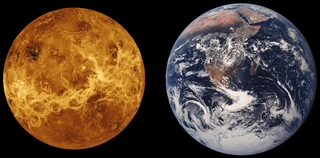Facts About Venus
Overview
- Venus is the second closest planet to the Sun
- It is the second brightest natural object in the nightsky
after the Moon
- Venus rotates clockwise unlike all the other planets in the Solar System
- with the exception of Uranus
- One day on Venus lasts 243 Earth days but the planet only takes 224.7 Earth
days to complete an orbit around the Sun.
Size and Distances
- Venus is about 67 million miles or 108 million kilometres from the Sun
- Once referred to as Earths twin, Venus is almost the same size of it -
7521 miles (12104 km) to 7926 miles (12756 km) across
- At its closest to Earth, Venus would be 38 million miles or 61 million kilometres away
- This means that Mercury spends more time closer to Earth than Venus
Composition
- Venus's core is similar to Earth in that it has an Iron Core surrounded by
a hot Rock Mantle
- The surface is made up of valleys and large volcanos that are very active
- Its surface is relatively smooth compared to the other rocky planets due to lack
of crater formation and also volcanic activity "smoothing" out the surface.
- Venus's thick atmosphere would also contribute to this smoothness of surface as meteorites etc
would bounce or skim off it and back into space
Temperature and Atmosphere
- Although Venus is not the closest planet to the sun, it is the hottest surface temperatures
pushing towards 482 degrees celsius
- The atmosphere of Venus is primarly Carbon Dioxide which drives a Greenhouse effect
- The clouds are composed of Sulfuric Acid
- The Atmospheric pressure on the surface of Venus is the equivalent of being 0.6 miles or 1 kilometre
deep in the ocean




